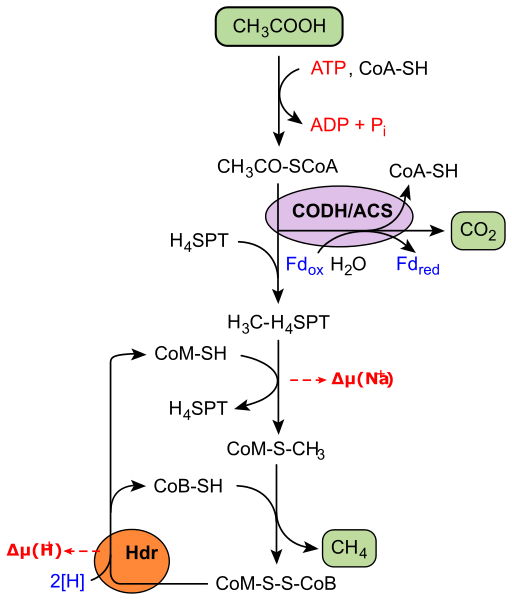Difference Between Methanogens and Methanotrophs
Key Difference – Methanogens vs Methanotrophs
Environmental biology is a main branch of biology which deals with processes of the environment. The involvement of microorganisms in these processes is of great importance as it speeds up the reactions and facilitates the conversion of substrates from one form to another. Methane (CH4) is named as a green house gas or a bio gas and its cycling in nature is governed mainly by microorganisms. Methanogenesis is a process where microorganisms produce methane from organic sources; Methanogens are the microorganisms involved in this process. Methane digestion is another important process where methane is utilized by microorganisms known as methanotrophs. Thus, the key difference between methanogens and methanotrophs is that methanogens produce methane whereas methanotrophs utilize methane.
CONTENTS
1. Overview and Key Difference
2. What are Methanogens
3. What are Methanotrophs
4. Similarities Between Methanogens and Methanotrophs
5. Side by Side Comparison – Methanogens vs Methanotrophs in Tabular Form
6. Summary
What are Methanogens?
Methanogens are a group of extremophiles that live in strictly anaerobic environments as they are obligate anaerobes. The presence of oxygen is highly toxic for methanogens. Methanogens belong to the domain Archea. Common habitats of methanogens are anaerobic digesters, anoxic soils and the gastrointestinal tracts of higher level organisms such as ruminants or humans. The process of methanogenesis provides energy for the survival of methanogens and the main substrates involved in methanogenesis are hydrogen, carbon dioxide, acetate compounds and C-1 compounds such as methanol.
CO2 + 4H2 → CH4 + 2H2O
CH3COO– + H2O → CH4 + HCO3
Methanogens are commercially used in waste water treatment processes, where anaerobic digestion of organic compounds is carried out. The process of anaerobic sludge digesters utilize methanogens to digest the waste. Methanogens are also used in the process of Bio Gas production where methanogenesis is the final step of Bio gas production.

Figure 01: Methanogenesis
Examples of methanogens include Methanococcus, Methanobacterium.
What are Methanotrophs?
Methanotrophs or Methanophiles are methane loving microorganisms. They are mostly gram negative bacteria that have the ability to utilize methane as its carbon and energy source. Methanotrophic bacteria utilize methane in an enzyme catalyzed reaction to produce carbon dioxide. This process takes place under aerobic conditions (in the presence of oxygen) and enzymes known as methane monooxygenases are involved in this reaction process. Methanotrophic bacteria can undergo two fates depending on its requirement during the process of methane digestion. Depending on the route it takes there are two types of methanotrophs as type 1 and type 2.
Examples of methanotrophs are Methylomonas, Methylobacter, Methylococcus, Methylocystis and Methylosinus.

Figure 02: Methanotrophs
Methanotrophs are utilized in controlling methane levels in the biosphere as methane is a strong green house gas which contributes to pollution in the form of global warming. Methanotrophs are also incorporated in digesting methane which is an end product in some industrial processes.
What are the Similarities Between Methanogens and Methanotrophs?
- Methanogens and Methanotrophs are extremophiles.
- Both are involved in control and cycling of methane.
- They are industrially important in waste water treatment processes and solid waste management
What is the Difference Between Methanogens and Methanotrophs?
Methanogens vs Methanotrophs | |
| Methanogens are microorganisms that are capable of generating methane from organic sources. | Methanotrophs or Methanophiles are microorganisms which are capable of utilizing methane as a source of carbon and energy. |
| Oxygen Requirement | |
| Methanogens are obligatory anaerobic (Methanogenesis takes place under anaerobic conditions). | Methanotrophs are aerobic (Methane digestion takes place under aerobic conditions). |
| Precursors of the Reaction | |
| Precursors of methanogenesis are hydrogen, carbon dioxide and C-1 compounds. | Methane is the precursor of methanotroph reactions. |
| End Products | |
| Methane is the end product of methanogenesis. | Carbon dioxide and energy are produced during the methane utilization. |
| Applications | |
| Methanogens are used in waste water purification plants in anaerobic digesters and sludge treatment systems, and in bio gas production plants. | Methanotrophs are used in degrading methane based products and methane emissions in industrial reactions. |
Summary – Methanogens vs Methanotrophs
Methanogens and Methanotrophs are biologically important types of bacteria which facilitate the balance of methane in nature and behave synergistically. Methanogens produce methane which is utilized by methanotrophs as their carbon and energy source. This concept is further utilized in industrial processes of waste management of solids and waste water and is, therefore, a topic of research among the environmental microbiologists. Methanogens produce methane and methanotrophs utilize methane as an energy source. This is the key difference between methanogens and methanotrophs.
Download PDF Version of Methanogens vs Methanotrophs
You can download PDF version of this article and use it for offline purposes as per citation note. Please download PDF version here Difference Between Methanogens and Methanotrophs.
References:
1. Hanson, R. S., and T. E. Hanson. “Methanotrophic bacteria.” Microbiological Reviews. U.S. National Library of Medicine, June 1996. Web. Available here. 15 Aug. 2017.
2. Triantafyllou, Konstantinos, Christopher Chang, and Mark Pimentel. “Methanogens, Methane and Gastrointestinal Motility.” Journal of Neurogastroenterology and Motility. Korean Society of Neurogastroenterology and Motility, Jan. 2014. Web. Available here. 15 Aug. 2017.
3. Whitman, William B., Timothy L. Bowen, and David R. Boone. “The Methanogenic Bacteria.” Springer. Springer New York, 01 Jan. 1970. Web. Available here. 15 Aug. 2017.
Image Courtesy:
1.” Methanogenesis acetate” Von Yikrazuul (talk) – Eigenes Werk (CC BY-SA 3.0) via Commons Wikimedia
2. “Methylococcus capsulatus” De (Image: Anne Fjellbirkeland) – The Genome of a Methane-Loving Bacterium. PLoS Biol 2/10/2004: e358. http://dx.doi.org/10.1371/journal.pbio.0020358 (CC BY 2.5) via Commons Wikimedia
ncG1vNJzZmivp6x7pbXFn5yrnZ6YsqOx07CcnqZemLyue8OinZ%2Bdopq7pLGMm5ytr5Wau265xK2fmqafnLKvv4yapZ1lpqh6rrHToZinp6SnvLG00mg%3D